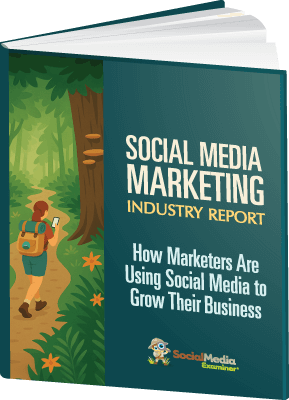Are you treating AI like an intern when it could be your chief marketing officer? Wondering how to transform AI from a basic task assistant into a strategic partner for your business?
In this article, you'll discover how to build your very own AI chief marketing officer that can help you analyze data, provide strategic advice, and create compelling content.
The Transformative Benefits of Building an AI Chief Marketing Officer
For solopreneurs and small teams of one to three people, hiring a full-time CMO or even a fractional marketing director with a budget of one hundred and fifty thousand dollars simply isn't feasible. Yet these are often the very businesses that need strategic marketing guidance the most.
Erika Stanley works primarily with women entrepreneurs who are incredibly scrappy, highly capable, and often former gifted kids. These business owners are used to doing everything themselves. But eventually, you hit a plateau where you literally cannot take on any more work. Your referral network starts to dry up, and you find yourself asking questions like: Should I be running Facebook ads? Do I need a content strategy? What even is a content strategy? How do I get more visible and get myself out there?
What these businesses need at this point is a strategic marketing partner. That's exactly where an AI CMO can step in.
Imagine having the collective wisdom of every marketing expert at your fingertips—someone who has read everything that Gary Vee has ever written, someone who is well-versed in Amy Porterfield and all of her courses, someone who understands the ins and outs of social media from consuming years of content from top influencers. Then imagine taking all of that expertise and applying it specifically to your business, your brand, and your goals. That's what an AI CMO can do for you.
The remarkable part is that you can access all of this for as little as twenty dollars a month. What if you could have access to all the insights and wisdom written by all the greatest marketers—including those who may not even be living anymore, like Ogilvy, or professional copywriters whose work has shaped the industry? When you have access to that knowledge, and more importantly, access to insights that can be highly customized to your business, you gain a strategic sparring partner and thought partner who can help you identify problems with your current marketing, figure out paths forward, and come up with strategic plans specifically for your situation.
It's incredibly powerful to have all of that knowledge at your fingertips. Anyone can access this by reading books and gathering resources, but when you're able to tie that knowledge in with AI and with business insights that are specific to you, your business, and your goals, it really turns up the volume on what you're able to do with that knowledge and expertise.
#1: The Foundation: Gathering the Right Data Before You Build Anything
The inspiration for building an AI CMO actually came from a colleague of Stanley's who had built an AI CFO because bookkeeping and finance were just the bane of her existence. She needed somebody that she could tap in and just gut check with, asking questions like: I want to invest in this course—is this in my budget? Is this in my best interest for my goals and my business? She runs every business decision she makes by her CFO first. Stanley took that idea and built on top of it, creating a comprehensive approach to building an AI CMO.
The critical first step is to start with strategy, not the tool. Don't worry about jumping straight into ChatGPT or Claude. You need to start with the foundation.
This is actually the first phase of Stanley's Brand to Bot Blueprint that she does with all of her clients. There are three really critical pieces that you need to gather before you start building anything. These foundational elements will determine how effective your AI CMO becomes.
Document Your Brand and What Makes You Uniquely You
First, you need to document your brand. What is your brand, or really, who is your brand? What makes you different from the dozens of other people in your market, in your space, in your niche who are doing the exact same thing that you do? Why would clients work with you instead?
This is where you can really get into the authenticity of AI. Adding in these little pieces of you will transform generic outputs—we've all been there, where you ask a question and you just get something that kind of sounds like everybody else, or it's a little bit mediocre—into responses that make you think: Wow, that sounds like it just came out of my mouth.
You can start with something as simple as your bio, your about page, and things that you have already written about yourself. Client testimonials are incredibly valuable. Transcripts of phone calls where you have been on calls with clients and they have just been raving about how happy they are about working with you—those little pieces, those little magical puzzle pieces, really start to paint the picture of why somebody would work with you instead of somebody else who does the same thing.
AI Is No Longer Optional for Marketers—Ready to Master It?
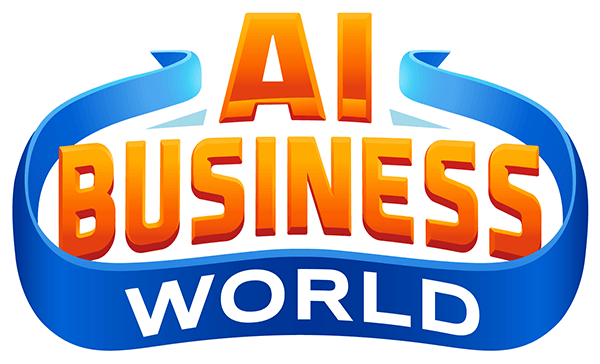
Join over a thousand forward-thinking marketers at AI Business World—a conference-in-a-conference at Social Media Marketing World.
Get two days of practical AI training where you'll discover:
✅ Systems that 3x your output—leaving time for strategy and creativity
✅ Proven strategies you can deploy right away—no guesswork, no wasted budget
Become the indispensable AI expert your company needs.
GET YOUR TICKETS—SAVE $400Think about your unique perspective or approach. How do you tackle a problem that's different from everybody else? What is your soapbox, that hill you would die on in terms of your industry? Those are all of the little things that you can add to begin building a profile for your brand that will go into your AI system.
Create a word bank of words and phrases that are things that you say over and over again. Stanley always signs off her emails with “cheers,” for example. Having little things like that which your AI can reference just makes it that much more authentic, makes it sound more like you rather than showing the little AI tells that we see when we're reading content and thinking: hmm, that sounds like the robots wrote it.
Voice and values are crucial elements to include. Values are huge. Voice can be hard for people to pin down themselves. Those of us who have an AI assistant that comes to all of our meetings are sitting on a literal goldmine of voice information. You can go into transcripts of any of your calls—they don't even have to be client calls—and pull those transcripts and use AI, use ChatGPT, to help pull out common words and phrases that you use when you are talking about things that light you up.
If you're on a workspace account with Google and you ever record Google Meets, you've got probably endless transcripts where you had conversations with your team.
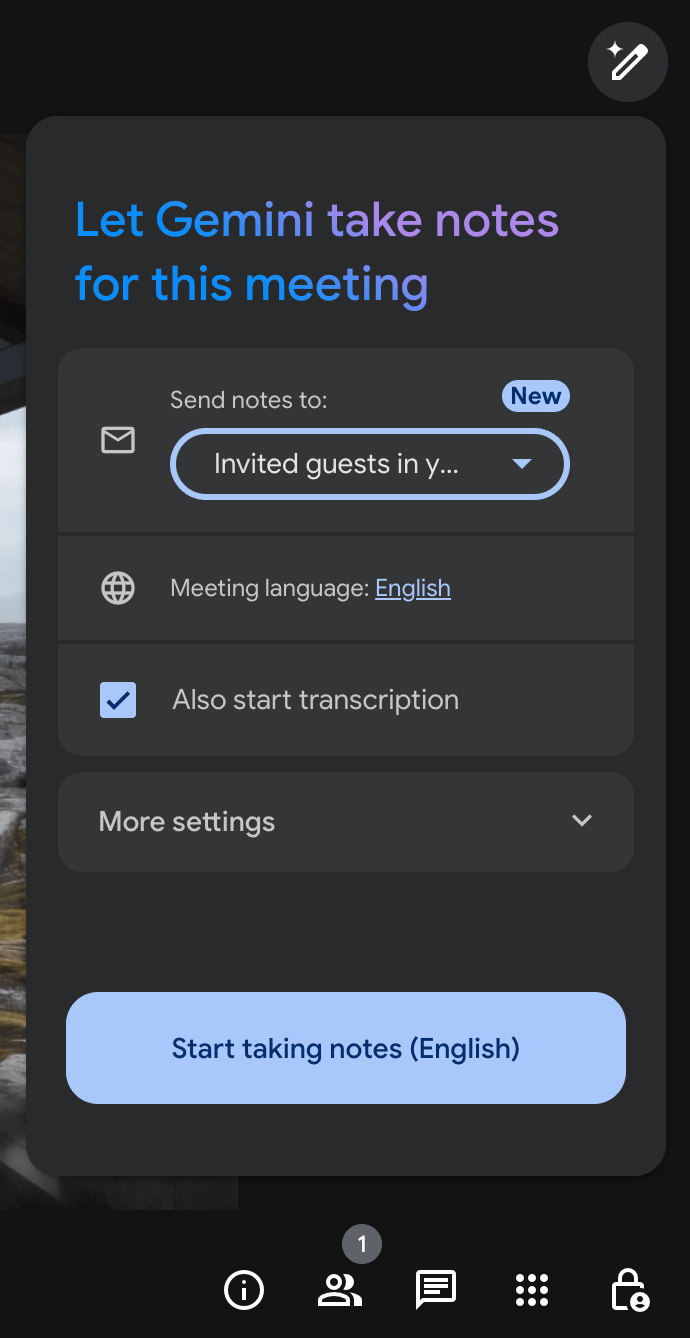
Usually, it does identify who's talking. You could just feed all that right into AI and ask it to pull out some of the recurring messages that you seem to say over and over again, or ask for an analysis of the way that you communicate.
Define Your Business Goals and the Why Behind Them
The next step in the gathering phase is clarifying where you see your business going and what you're trying to accomplish. When you start a marketing campaign, you're not just going to start with a goal like: I want ten thousand followers on Instagram. You need to ask why. Why do you want ten thousand followers? What is that getting you? What's the big picture? Ten thousand followers doesn't mean anything if it's not converting into revenue for your business.
You have to think about what the big picture is. What is the end goal? You can pull this from your business plan, your vision statements, even those late-night Apple Notes entries—notes to yourself where you kind of dream and you're honest about where you want to be in three to five to ten years. Any of those can go into helping to define the business goals that you want to share with your new AI CMO.
Establish the Role of Your AI Chief Marketing Officer (CMO)
The last piece of the foundation is defining the role. Of the three pieces—your brand, your goals, and the role—this is where you tell AI that you want it to be a CMO.
If you had an unlimited marketing budget and could hire any expert, if you could hire Seth Godin, if you could hire the top influencers in your industry, what expertise would you want them to bring? Here's where the magic piece comes in: You can actually feed all of this expertise into your AI CMO.
You might have to think a little bit. You might have to dig or use ChatGPT or Claude's deep research to figure out where you can pull that expertise from. Do they have blogs? Do they have a podcast? Are the transcripts of those podcasts available? Can you pull an RSS feed? Do they have a YouTube channel?
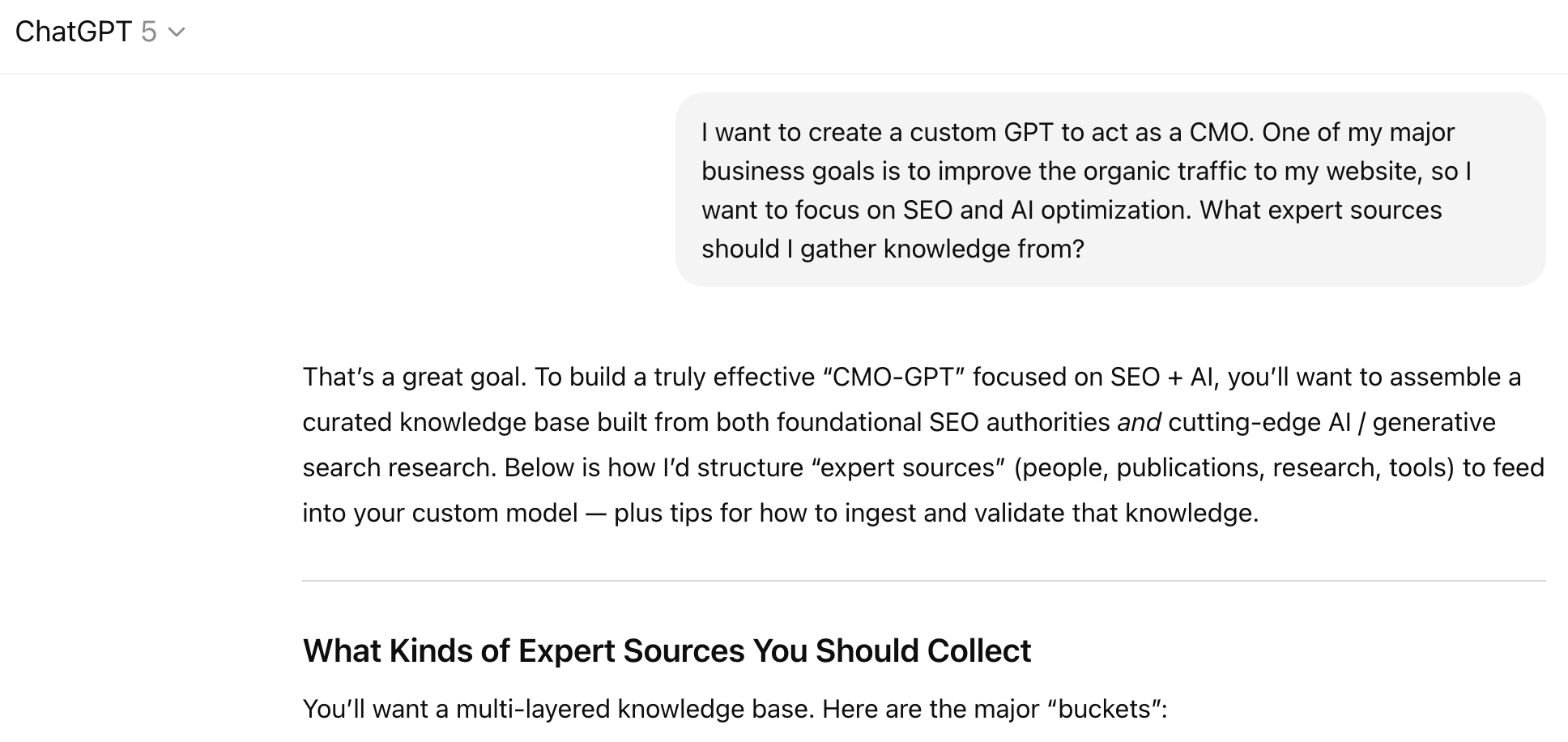
Let's say that one of your major business goals is to really improve the organic traffic to your website, so you want to focus on SEO and AI optimization. You might decide that if you could hire Rand Fishkin to come in and take over that piece of your business, that would be ideal. Now, where are you going to find the thought leadership that Rand Fishkin is sharing about SEO and AIO, and how can we as business owners utilize his strategies in our business? You can pull in that thought leadership and start to create these documents as little repositories of information.
You're making a little reference book—not even in your head, but an actual reference document for yourself—and you're going to feed that straight to the AI.
The key is to define the ideal CMO with all the experience of multiple experts. They might have all the experience of Seth Godin when it comes to creative purple cow marketing stuff. They might have all the search knowledge of Rand Fishkin. They might have all the marketing savvy of Amy Porterfield. You pick these people, and then you actually go out and you find data out there that summarizes some of their stuff, and you're gathering up this insight.
It's one thing to say your AI CMO has the insights of Seth Godin. It's another thing to give AI Seth's blog and tell it to read everything. Seth has been publishing his blog for twenty-five years, so he has a huge encyclopedic reference on different marketing topics. It's going to be a lot for your AI to pull from all of that, so it would behoove you to go and read and find the best pieces that serve your particular goals.
You can use deep research capabilities in these AI tools to help you. You might say: Go find some of the signature pieces of content by this influencer that are on this topic—maybe growing a small business or whatever is relevant to your needs. Then it will go out and find that information. You could probably ask it to reverse engineer the essence of that information into a piece of data that you can add to your knowledge base.
It's kind of like creating a Frankenstein CMO, but with a much better outcome than the original story.
#2: 3 Platforms to Build Your AI CMO
Once you're out of the data-gathering phase, you can start actually building your AI CMO. Stanley's own process with this has been a bit messy, but she wants to share this journey transparently.
Stanley likes to work messily when working with AI. She usually has her AI screen on one side and uses Apple Notes for everything on the other side, constantly copying and pasting and switching and moving. That's not what she preaches, by the way—she preaches that you should pick a platform and get really good at it, but that's not what she does. She bounces between platforms.
Start With a ChatGPT CustomGPT
Stanley started this journey by creating a custom GPT.

She did a workshop on this and created a freebie called her Bish Please system—her Brand-Informed Systems Hub. Basically, it was a way to gather all of this information and put some in the instructions for the custom GPT and then some stuff that would go in the knowledge base.
She has her own Mile End Bish system that is her CMO system, a custom GPT that she can either start a conversation with or, if she's already started another conversation in ChatGPT, she can tag a custom GPT into a conversation. If you haven't done that, it's very cool.
Over on the left-hand sidebar in ChatGPT where you've got all of your custom GPTs pinned, if you're in just a regular conversation and you want to bring in your custom GPT—imagine this is an actual person you're bringing into the conversation, into the room—you type the at symbol and then start to type out the name of that custom GPT. They'll pop up, and you can select them. Then, their entire knowledge base and their custom GPT instructions are in that conversation.
That's how Stanley started, by creating this custom GPT that was the CMO for her business that she could bring into conversations she was having.
Move to Claude Projects
Stanley then moved over to Claude, and the reason she did that was because she started using Claude Projects more since it would generate artifacts. If you haven't seen artifacts, they pop up over on the right-hand side as separate individual documents.

As she was using the CMO, she took the easy route and copied the same instructions from her custom GPT. It was almost the exact same knowledge base, and she just popped that into a Claude Project.
Ready to Supercharge Your Marketing Strategy?
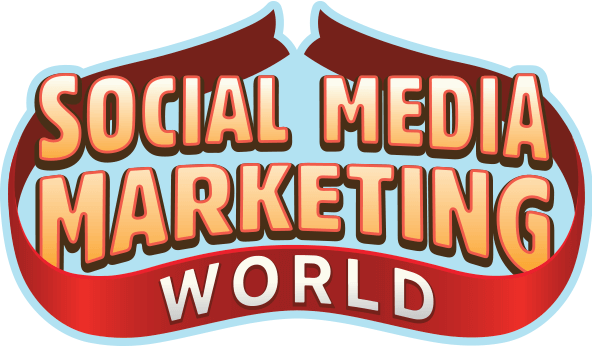
Get expert training and an unbeatable conference experience when you attend Social Media Marketing World—from your friends at Social Media Examiner.
Broaden your reach, skyrocket your engagement, and grow your sales. Become the marketing hero your company or clients need!
🔥 Save $900 on an All-Access ticket. Sale Ends Friday! 🔥
GET THE DETAILSBut as she was talking with it, she could tell it to create an artifact, and it would generate separate documents: here's your LinkedIn posts for this campaign, here's your blog post for this campaign, here's your three newsletter ideas. It puts those into separate artifacts, which are then super easy to save, and it helps keep everything organized.
Stanley loves the artifacts portion of working with Claude Projects. The artifacts look like little Microsoft Word documents or Google Docs, but they can also do a lot more. They are very, very sophisticated.
ChatGPT has something called Canvas, which is very similar, but Stanley has used Canvas a bit with ChatGPT and ends up getting frustrated because you'll go to change something in the Canvas and then it will just change it back for no clear reason. She kind of gave up on Canvas and has switched over to artifacts.
What's great about both ChatGPT Projects and Claude Projects is that they have memories. They'll remember the prior information that you interacted with them on, and that can be incrementally more valuable for you down the road, because if you have a bunch of threads, all that information is available in the memory.
Advance to Poppy AI
Stanley has been using Poppy AI for about the past eight months. If you've ever used Miro or any of the virtual whiteboards, Poppy is like a visual way to seed information into AI—kind of like a flow chart where you just draw things on the screen and connect them.
You can pop all kinds of links into Poppy. Stanley was able to pull some Alex Hormozi TikToks. She was able to pull Instagram Reels. She can pull YouTube videos directly.
One of the cool things about Poppy versus Notebook LM—which will also work for building an AI CMO and does almost the same thing—is that Poppy will let you pull in unlisted YouTube videos. Stanley has recorded things that she has unlisted on her YouTube channel that wouldn't pull into Notebook LM.
Poppy is able to see the video within TikToks. It's able to see what's in an Instagram Reel. It can see the individual pieces of a carousel. So instead of you having to take screenshots of everything, it's really cool and really advanced.
Because Stanley is a visual person—and she knows so many of us are visual people—being able to actually see what pieces are connected at any given time helps her stay organized, ask better questions, and stay on task when she is talking with her AI CMO.
If she's working on an email campaign, she doesn't necessarily need all of the information connected. She doesn't need it to think that hard about all of the other pieces. She might just tap in the information on her brand, on her goals, and on the high-level email strategy and have it focus its attention on that.
With both ChatGPT and Claude, the system is pulling from the entire knowledge base the whole time. The bigger the knowledge base gets, the slower it gets and the more it can get confused. With Poppy, because it's visual, you can just X out a connection and you can actually see the little connection just disappear. You can just connect the pieces that are useful for whatever you are asking it to do at the time.
The other benefit of Poppy over Notebook LM is that you have access to web search. So it's not just pulling from those documents—it's also pulling from the models that you're using. You can choose the models. You can choose to use Gemini, Claude, or ChatGPT. Stanley usually uses Claude Sonnet, but you can switch it up if you're not getting the responses that you want. If you're looking for something a little different, you can switch the model right there within the chat window and try to regenerate that response with a different large language model, which is really cool.
Both Google's Notebook LM and Poppy AI are effectively aggregating information from multiple media and then allowing you to do something with that information. Notebook LM is fascinating because it only works with the data that you give it. It's powered on the backend by Google Gemini Pro, but it's effectively just working with whatever you load into it. That's why they call it a notebook—you have to add stuff into it. You add docs, videos, multimedia content, and then you can query all that insight.
Poppy AI does the same thing but has a larger base of content from which you can pull. It does it in a different way, which is more of a drag-and-drop visual approach.
For those people who are confused at this point, the recommendation is to go with a custom GPT or a Claude Project. For people who are a little more advanced, you could start experimenting with Poppy and Notebook LM. You could successfully build a CMO with any of these solutions.
Stanley still uses her custom GPT CMO all the time, but she currently uses Poppy the most because of its visual interface and flexibility.
#3: 3 Ways to Use Your AI CMO
Once you've built your AI CMO, the question becomes: how do you actually query it to make it act as a strategic marketing partner? With Claude Projects and custom GPTs, you just ask it whatever you want. With Poppy, the process is slightly different but equally straightforward.
With Poppy, Stanley has all of the information-gathering pieces saved in a folder she calls her brand board. She's got all of the documents in a little folder. The very first thing she connects in Poppy is her brand board, and she says something like: Hey, I am working on this campaign. I'm going to be on a podcast, and I want to make the most of this opportunity. Let's brainstorm some ideas for marketing campaigns. First step is I want you to learn about my brand, my goals, and my services.
She connects that piece and has it learn about her. This is a key difference and somewhat of a downside with Poppy compared to ChatGPT or Claude: With those platforms, when you're starting with a Claude Project or a custom GPT, it already knows everything—it's in the instructions, it's in the knowledge base. You don't have to connect it and say learn about me. With Poppy, that is the first step every single time. It starts with amnesia, for lack of better words. It doesn't know what it's supposed to do or what you're about. You're almost setting a little workflow in place.
Once she attaches her brand board and has it learn about her brand, she connects the little marketing pieces. Then she connects her experts—she's got a Seth Godin folder, a Michael Stelzner folder, an Amy Porterfield folder. She can connect all of those and then use the voice dictation within Poppy for stream-of-consciousness conversation.
Poppy has a really cool voice dictation feature, similar to what ChatGPT has—not the one where you can talk back and forth with ChatGPT in real time, but just the little microphone there in the query window where you can dictate and just talk to it. She tells it what she's thinking, what ideas she has, and then has it do its thing. It can use the expert knowledge that she has already gathered and is already hooked into.
She can have a conversation back and forth with these experts through the chat window that's connected to Claude—or whichever model she's chosen to use.
Because Poppy AI is one of those aggregator services, it uses the APIs of pretty much all the tools that are out there. In Stanley's case, she's chosen Claude Sonnet. That's the interface in which she's communicating, and it's kind of similar to her actually being in Claude, except it's just like a fresh little window with more control over what information is being accessed.
Stanley uses her AI CMO in three primary ways: analytics, advisory, and content creation. Each serves a distinct purpose in her marketing strategy.
Analytics: Understanding What's Working
The first use case is analytics. Stanley just finished up season one of the AI Queens podcast and is about to launch season two. She was able to pull all the analytics from her podcast platform—information on how many downloads she has, how long people listened, where they were listening, and what the titles of those podcasts were. She got analytics from the podcast platform, Substack, and YouTube.
She was able to put all of that information into her custom GPT and ask: Hey, here's all my analytics. What are some of my best-performing podcasts? What did they have in common? I'm trying to plan out some topics for next season. Based on what performed really well, what are some ideas for podcasts that I could plan for in the future?
This approach works for any kind of content. If you have a blog or an ongoing newsletter, newsletters are great because most newsletter systems have a ton of analytics that you can just export as a CSV and upload. You can analyze open rates, click-through rates, what the subject lines were, and what links people clicked on when they did click-through. All of those analytics exist and can be fed into your AI CMO.
If you're looking at a social media campaign, you can pull all of your analytics from Meta. You can put all of that into your AI system and say: Hey, let's analyze this. What is the data telling us? What worked well? What are some gaps? What could we be doing next?
By using ChatGPT and Claude, you've got these deep thinking and research capabilities where you can ask it to go out and look at what people in your audience are talking about. What are they saying on social media and Reddit? What are some pain points that they have? Now, how can you create campaigns based on what was successful for you in the past, what your business goals are for the future, and what your audience really, really needs from you? What are some campaigns that you can create for this next chapter of your business?
You can also pull screenshots of analytics from various platforms. These AI models will read the screenshots and help you make sense of the data.
Advisory: Your Strategic Sparring Partner
The second use case is an advisory role or a strategic partner. This is where you can really dig in and work with those different expert perspectives where you have gathered all of the information and all of the insights, the thought leadership from various marketing experts.
You can say something like: You've got all this information, you know my brand, my business goals, my growth trajectory—what do I need to be doing over the next six months to help me hit my year-end goals? Here's my revenue for the last six months, and here's where I want to be. What do I need to do? Oh, AI CMO, advisory friend of mine, what do I need to be doing over the next six months? What shifts do I need?
They can act as that brainstorming and advisory partner.
Especially if you are an entrepreneur, often you don't have people to talk to who are super smart because your friends are also entrepreneurs, and they're busy. Having some system that's been well-trained that you can kind of spar with and ideate with—where you can say, what do you think about this, or how would you go about doing this, or what are your thoughts on this—is super, super valuable.
One important caution with this advisory role is that ChatGPT likes to be super agreeable and positive, like: Hey, girl, that's the best idea ever. Stanley challenges everyone to push back if it seems too positive or agreeable. Ask it to help find your blind spots. We all have them, and it's nothing to be embarrassed about. But what are some blind spots that you might have in your business that are holding you back? Ask the AI to ask you questions until it can help you really get to the root of what is holding you back from getting to the next stage of your business.
Claude is not as sympathetic as ChatGPT. With Claude, you can ask it to be critical, and it will. Stanley's Claude often says things like: Yeah, that's an eight point five out of ten. And it's just waiting for her to say: Well, how can I make it a ten? It'll tell you things like: You skipped this thing that I recommended. It actually is much more straightforward and valuable in that regard.
Content Creation: Leveraging Expert Insights
The last example is what a lot of entrepreneurs are using AI for already, and that's content creation. But instead of just asking it to create social media posts, you're really using the best and brightest minds and thought leadership to help you come up with social media posts, blog posts, and newsletters that are really tapping into your ideal audience.
By training your AI CMO on your soapbox topics and feeding in information about your business, your brand, and your audience at the very beginning, it helps you come up with better campaign ideas than you, as a non-marketer, would have come up with on your own. It's pulling that information you fed into it at the beginning and helping to create content that actually reflects your unique voice and perspective while being informed by the strategies of the experts whose knowledge you've incorporated.
Erika Stanley is an AI strategist who helps women business owners easily build systems that grow visibility and revenue with AI. She's the host of the AI Queens Podcast and founder of the AI Queens Society. Her creative agency is Mile End Digital. Follow her on Instagram and LinkedIn.
Other Notes From This Episode
- Connect with Michael Stelzner @Stelzner on Facebook and @Mike_Stelzner on X.
- Watch this interview and other exclusive content from Social Media Examiner on YouTube.
Listen to the Podcast Now
This article is sourced from the AI Explored podcast. Listen or subscribe below.
Where to subscribe: Apple Podcasts | Spotify | YouTube Music | YouTube | Amazon Music | RSS
✋🏽 If you enjoyed this episode of the AI Explored podcast, please head over to Apple Podcasts, leave a rating, write a review, and subscribe.
Stay Up-to-Date: Get New Marketing Articles Delivered to You!
Don't miss out on upcoming social media marketing insights and strategies! Sign up to receive notifications when we publish new articles on Social Media Examiner. Our expertly crafted content will help you stay ahead of the curve and drive results for your business. Click the link below to sign up now and receive our annual report!
AI Is Transforming Marketing—Are You Keeping Up?
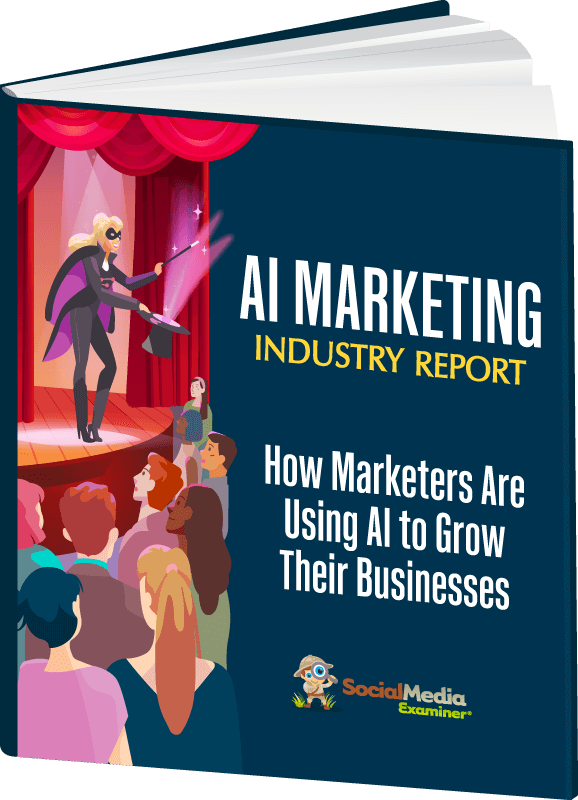
Marketers are rapidly adopting AI to transform their work. Our new 2025 AI Marketing Industry Report surveyed over 730 marketers to reveal the tools, tactics, and trends shaping the industry, including
🔥 90% of marketers save time with AI—discover the top use cases
🔥 The 5 biggest challenges marketers face with AI and how to overcome them
GET THE AI MARKETING INDUSTRY REPORT
